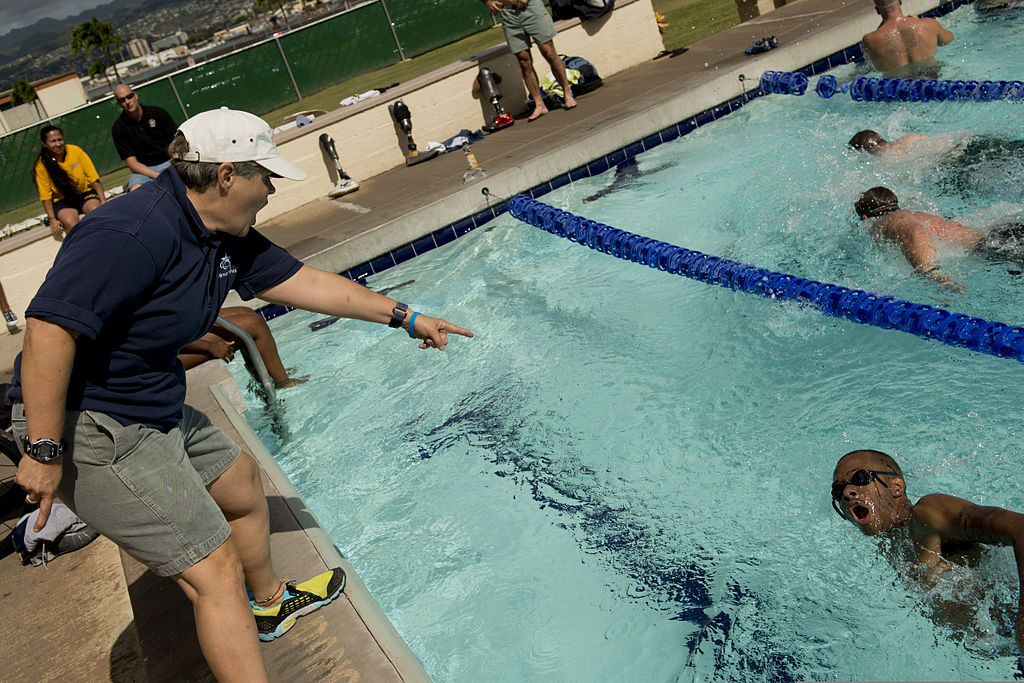O Efeito do Incentivo Verbal no Desempenho e na Fadiga Muscular na Natação

Downloads
Palavras-chave:
Eletromiografia De Superfície, Respostas Fisiológicas, Feedback Verbal, Motivação, Atletas De Elite, Otimização De PerformanceResumo
O encorajamento verbal (VE) pode ser usado para melhorar o desempenho em vários esportes, embora nenhum estudo tenha sido realizado em nadadores e apenas alguns efeitos tenham sido relatados em atletas de elite. Além de influenciar o desempenho motor, o VE também é conhecido por aumentar a carga física, aumentando potencialmente a probabilidade de desenvolver fadiga. Pensando nisso, este estudo teve como objetivo explorar os efeitos do VE em nadadores, a fim de preencher a lacuna de conhecimento sobre o meio aquático. Materiais e Métodos: Cada atleta nadou uma prova máxima de 200 m livre em duas condições diferentes: uma prova com VE e outra sem VE. As duas principais medidas de resultado foram: [1] velocidade de desempenho (m/s); e [2] fadiga muscular, investigada por meio de eletromiografia de superfície. Foram recrutados 60 nadadores, com idade de 18,63 ± 3,46 anos (mediana 18 anos), sendo 28 homens (47%) e 32 mulheres (53%), com 7,03 ± 3,9 anos de experiência. Resultados: Com VE, o desempenho melhorou significativamente na prova de natação (p < 0,001, tamanho do efeito (ES) -0,95, grande). Ao dividir os resultados na primeira metade (primeira (0–100 m) vs. segunda metade (100–200 m)), o ES foi grande na primeira parte (-1,11), indicando uma melhora no desempenho. Isso piorou, no entanto, na segunda parte do teste (ES 0,63). Na análise multivariada, os anos de experiência foram um preditor significativo da mudança no desempenho geral (p = 0,011). Houve um aumento significativo na fadiga muscular induzida por VE, em geral, e durante a segunda metade, mas não durante a primeira metade do teste. Conclusões: O presente estudo indica que o VE durante uma prova de meia distância (200 m) aumenta mais o desempenho em nadadores com pouca experiência. No entanto, tem um impacto negativo na fadiga.
Referências
(1) Midgley AW, Marchant DC, Levy AR. A Call to Action towards an Evidence-Based Approach to Using Verbal Encouragement during Maximal Exercise Testing. Clin. Physiol. Funct. Imaging 2018, 38, 547–553.
(2)McCormick A, Meijen C, Marcora S. Psychological Determinants of Whole-Body Endurance Performance. Sports Med. 2015, 45, 997–1015.
(3)Edwards AM, Dutton-Challis L, Cottrell D, Guy JH, Hettinga FJ. Impact of Active and Passive Social Facilitation on Self-Paced Endurance and Sprint Exercise: Encouragement Augments Performance and Motivation to Exercise. BMJ Open Sport Exerc. Med. 2018, 4, e000368.
(4)Kilit B, Arslan E, Akca F, Aras D, Soylu Y, Clemente FM, Nikolaidis PT, Rosemann T, Knechtle B. Effect of Coach Encouragement on the Psychophysiological and Performance Responses of Young Tennis Players. Int. J. Environ. Res. Public Health 2019, 16, 3467.
(5)Andreacci JL, Lemura LM, Cohen SL, Urbansky EA, Chelland SA, Duvillard SP. von The Effects of Frequency of Encouragement on Performance during Maximal Exercise Testing. J. Sport. Sci. 2002, 20, 345–352.
(6) Sahli H, Haddad M, Jebabli N, Sahli F, Ouergui I, Ouerghi N, Bragazzi NL, Zghibi M. The Effects of Verbal Encouragement and Compliments on Physical Performance and Psychophysiological Responses During the Repeated Change of Direction Sprint Test. Front. Psychol. 2022, 12, 698673.
(7) Karaba-Jakovljevic D, Popadic-Gacesa J, Grujic N, Barak O, Drapsin M. Motivation and Motoric Tests in Sports. Med. Pregl. 2007, 60, 231–236.
(8) Belkhiria C, de MARCO G, Driss T. Effects of Verbal Encouragement on Force and Electromyographic Activations during Exercise. J. Sport. Med. Phys. Fit. 2018, 58, 8.
(9) McNair PJ, Depledge J, Brettkelly M, Stanley SN. Verbal Encouragement: Effects on Maximum Effort Voluntary Muscle: Action. Br. J. Sport. Med. 1996, 30, 243–245.
(10) Rendos NK, Harriell K, Qazi S, Regis RC, Alipio TC, Signorile JF. Variations in Verbal Encouragement Modify Isokinetic Performance. J. Strength Cond. Res. 2019, 33, 708–716.
(11) Binboga E, Tok S, Catikkas F, Guven S, Dane S. The Effects of Verbal Encouragement and Conscientiousness on Maximal Voluntary Contraction of the Triceps Surae Muscle in Elite Athletes. J. Sport. Sci. 2013, 31, 982–988.
(12) Obmiñski Z, Mroczkowska H. Verbal encouragement does not improve maximal isometric hand grip strength in male judokas. A short report. J. Combat. Sports Martial Arts 2015, 6, 63–66.
(13) Argus CK, Gill ND, Keogh JW, Hopkins WG. Acute Effects of Verbal Feedback on Upper-Body Performance in Elite Athletes. J. Strength Cond. Res. 2011, 25, 3282–3287.
(14)Engel FA, Faude O, Kölling S, Kellmann M, Donath L. Verbal Encouragement and Between-Day Reliability During High-Intensity Functional Strength and Endurance Performance Testing. Front. Physiol. 2019, 10, 460.
(15)Rampinini E, Impellizzeri FM, Castagna C, Abt G, Chamari K, Sassi A, Marcora SM. Factors Influencing Physiological Responses to Small-Sided Soccer Games. J. Sport. Sci. 2007, 25, 659–666.
(16)Sahli H, Selmi O, Zghibi M, Hill L, Rosemann T, Knechtle B, Clemente FM. Effect of the Verbal Encouragement on Psychophysiological and Affective Responses during Small-Sided Games. Int. J. Environ. Res. Public Health 2020, 17, 8884.
(17)Selmi O, Khalifa WB, Ouerghi N, Amara F, Zouaoui M, Bouassida A. Effect of Verbal Coach Encouragement on Small Sided Games Intensity and Perceived Enjoyment in Youth Soccer Players. J. Athl. Enhanc. 2017, 6, 16–17.
(18)Dias Neto JM, Silva FB, de Oliveira ALB, Couto NL, Dantas EHM, Nascimento MADL. Effects of Verbal Encouragement on Performance of the Multistage 20 m Shuttle Run. Acta Sci. Health Sci. 2015, 37, 25.
(19)Gandevia SC. Spinal and Supraspinal Factors in Human Muscle Fatigue. Physiol. Rev. 2001, 81, 1725–1789.
(20)Abd-Elfattah HM, Abdelazeim FH, Elshennawy S. Physical and Cognitive Consequences of Fatigue: A Review. J. Adv. Res. 2015, 6, 351–358.
(21)Sun J, Liu G, Sun Y, Lin K, Zhou Z, Cai J. Application of Surface Electromyography in Exercise Fatigue: A Review. Front. Syst. Neurosci. 2022, 16, 893275.
(22)Brody LR, Pollock MT, Roy SH, De Luca CJ, Celli B. PH-Induced Effects on Median Frequency and Conduction Velocity of the Myoelectric Signal. J. Appl. Physiol. 1991, 71, 1878–1885.
(23)Lindstrom L, Kadefors R, Petersen I. An Electromyographic Index for Localized Muscle Fatigue. J. Appl. Physiol. Respir. Environ. Exerc. Physiol. 1977, 43, 750–754.
(24)Merletti R, Sabbahi MA, De Luca CJ. Median frequency of the myoelectric signal. Effects of muscle ischemia and cooling. Eur. J. Appl. Physiol. Occup. Physiol. 1984, 52, 258–265.
(25)Puce L, Pallecchi I, Marinelli L, Mori L, Bove M, Diotti D, Ruggeri P, Faelli E, Cotellessa F, Trompetto C. Surface Electromyography Spectral Parameters for the Study of Muscle Fatigue in Swimming. Front. Sports Act. Living 2021, 3, 644765.
(26) Available from: http://www.swimnews.com/ipspoints
(27) Hermens HJ, Freriks B, Disselhorst-Klug C, Rau G. Development of Recommendations for SEMG Sensors and Sensor Placement Procedures. J. Electromyogr. Kinesiol.2000; 10, 361–374.
(28) Martens J, Figueiredo P, Daly D. Electromyography in the Four Competitive Swimming Strokes: A Systematic Review. J. Electromyogr. Kinesiol. 2015, 25, 273–291.
(29) Staude GH. Precise Onset Detection of Human Motor Responses Using a Whitening Filter and the Log-Likelihood-Ratio Test. IEEE Trans. Biomed. Eng. 2001, 48, 1292–1305.
(30) Knaflitz M, Bonato P. Time-Frequency Methods Applied to Muscle Fatigue Assessment during Dynamic Contractions. J. Electromyogr. Kinesiol. 1999, 9, 337–350.
(31) Sullivan GM, Feinn R. Using Effect Size—Or Why the P Value Is Not Enough. J. Grad. Med. Educ. 2012, 4, 279–282.
(31) Lakens D. Calculating and Reporting Effect Sizes to Facilitate Cumulative Science: A Practical Primer for t-Tests and ANOVAs. Front. Psychol. 2013, 4, 863.
(33)Rosenthal R. Meta-Analytic Procedures for Social Research, SAGE Publications: Newbury Park, CA, USA, 1991.
(34)Rosenthal R. Parametric Measures of Effect Size. In The Handbook of Research Synthesis, Cooper, H., Hedges, L.V., Valentine, J.C., Eds., Russell Sage Foundation: New York, NY, USA, 1994, pp. 231–244.
(35)Dankel SJ, Loenneke JP. Effect Sizes for Paired Data Should Use the Change Score Variability Rather Than the Pre-Test Variability. J. Strength Cond. Res. 2018. publish ahead of print.
(36)Mangiafico SS. Summary and Analysis of Extension Program Evaluation in R, Version 1.19.10, Rutgers Cooperative Extension: New Brunswick, NJ, USA, 2016.
(37) Siegel S. Nonparametric Statistics for the Behavioral Sciences. In International Student Edition, McGraw-Hill: London, UK, 1956, ISBN 978-0-07-057348-2.
(38) Cureton EE. Rank-Biserial Correlation. Psychometrika 1956, 21, 287–290.
(39) Glass GV. Note on Rank Biserial Correlation. Educ. Psychol. Meas. 1966, 26, 623–631.
(40)Cliff N. Dominance statistics: Ordinal analyses to answer ordinal questions. Psychol. Bull. 1993, 114, 494–509.
(41) van Doorn J, Ly A, Marsman M, Wagenmakers E-J. Bayesian Rank-Based Hypothesis Testing for the Rank Sum Test, the Signed Rank Test, and Spearman’s p. J. Appl. Stat. 2020, 47, 2984–3006.
(42) Romano J, Kromrey JD, Coraggio J, Skowronek J, Devine L. Exploring methods for evaluating group differences on the NSSE and other surveys: Are the t-test and Cohen’s d indices the most appropriate choices? In Proceedings of the Annual Meeting of the Southern Association for Institutional Research, Arlington, Virginia, 14–17 October 2006.
(43) Baker J. Early Specialization in Youth Sport: A Requirement for Adult Expertise? High Abil. Stud. 2003, 14, 85–94.
(44)Menting SGP, Hendry DT, Schiphof-Godart L, Elferink-Gemser MT, Hettinga FJ. Optimal Development of Youth Athletes Toward Elite Athletic Performance: How to Coach Their Motivation, Plan Exercise Training, and Pace the Race. Front. Sports Act. Living 2019, 1, 14.
(45) Rodríguez FA, Mader A. Energy Systems in Swimming. In World Book of Swimming: From Science to Performance, Nova Science Publishers, Inc.: New York, NY, USA, 2011.
(46) McGibbon KE, Pyne DB, Shephard ME, Thompson KG. Pacing in Swimming: A Systematic Review. Sports Med. 2018, 48, 1621–1633.
(47) Mauger AR, Neuloh J, Castle PC. Analysis of Pacing Strategy Selection in Elite 400-m Freestyle Swimming. Med. Sci. Sport. Exerc. 2012, 44, 2205–2212.
(48) Puce L, Chamari K, Marinelli L, Mori L, Bove M, Faelli E, Fassone M, Cotellessa F, Bragazzi NL, Trompetto C. Muscle Fatigue and Swimming Efficiency in Behind and Lateral Drafting. Front. Physiol. 2022, 13, 835766.
OBS.:
Artigo adaptado e traduzido para o português pelos editores de NADAR! SWIMMING MAGAZINE para republicação, conforme normas de submissão do periódico. Versão original em: https://www.mdpi.com/1648-9144/58/12/1709 LICENÇA ORIGINAL E DA ADAPTAÇÃO: https://creativecommons.org/licenses/by/4.0/.
Publicado
Como Citar
Edição
Seção
ARK
Licença
Copyright (c) 2023 Luca Puce, Carlo Trompetto, Antonio Currà , Lucio Marinelli, Laura Mori , Marco Panascì , Filippo Cotellessa, Carlo Biz, Nicola Luigi Bragazzi , Pietro Ruggieri

Este trabalho está licenciado sob uma licença Creative Commons Attribution-NonCommercial-NoDerivatives 4.0 International License.






